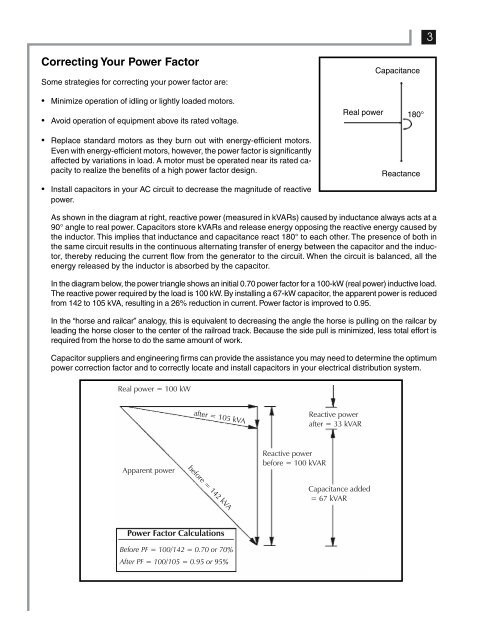Reducing Power Factor Cost - EERE - U.S. Department of Energy
Reducing Power Factor Cost - EERE - U.S. Department of Energy
Reducing Power Factor Cost - EERE - U.S. Department of Energy
You also want an ePaper? Increase the reach of your titles
YUMPU automatically turns print PDFs into web optimized ePapers that Google loves.
Correcting Your <strong>Power</strong> <strong>Factor</strong><br />
Some strategies for correcting your power factor are:<br />
Minimize operation <strong>of</strong> idling or lightly loaded motors.<br />
Avoid operation <strong>of</strong> equipment above its rated voltage.<br />
Replace standard motors as they burn out with energy-efficient motors.<br />
Even with energy-efficient motors, however, the power factor is significantly<br />
affected by variations in load. A motor must be operated near its rated capacity<br />
to realize the benefits <strong>of</strong> a high power factor design.<br />
Install capacitors in your AC circuit to decrease the magnitude <strong>of</strong> reactive<br />
power.<br />
Capacitance<br />
Real power 180°<br />
Reactance<br />
As shown in the diagram at right, reactive power (measured in kVARs) caused by inductance always acts at a<br />
90° angle to real power. Capacitors store kVARs and release energy opposing the reactive energy caused by<br />
the inductor. This implies that inductance and capacitance react 180° to each other. The presence <strong>of</strong> both in<br />
the same circuit results in the continuous alternating transfer <strong>of</strong> energy between the capacitor and the inductor,<br />
thereby reducing the current flow from the generator to the circuit. When the circuit is balanced, all the<br />
energy released by the inductor is absorbed by the capacitor.<br />
In the diagram below, the power triangle shows an initial 0.70 power factor for a 100-kW (real power) inductive load.<br />
The reactive power required by the load is 100 kW. By installing a 67-kW capacitor, the apparent power is reduced<br />
from 142 to 105 kVA, resulting in a 26% reduction in current. <strong>Power</strong> factor is improved to 0.95.<br />
In the “horse and railcar” analogy, this is equivalent to decreasing the angle the horse is pulling on the railcar by<br />
leading the horse closer to the center <strong>of</strong> the railroad track. Because the side pull is minimized, less total effort is<br />
required from the horse to do the same amount <strong>of</strong> work.<br />
Capacitor suppliers and engineering firms can provide the assistance you may need to determine the optimum<br />
power correction factor and to correctly locate and install capacitors in your electrical distribution system.<br />
Before PF = 100/142 = 0.70 or 70%<br />
After PF = 100/105 = 0.95 or 95%<br />
3

















